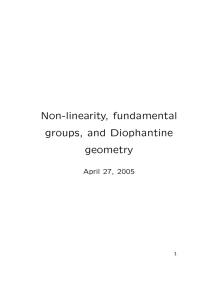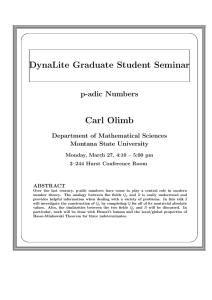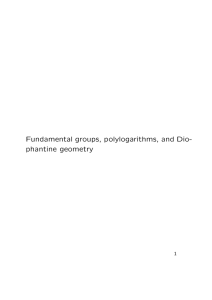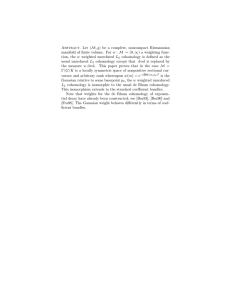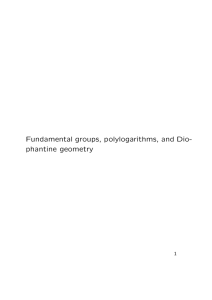Non-linearity, fundamental groups, and Diophantine geometry June 12, 2006
advertisement
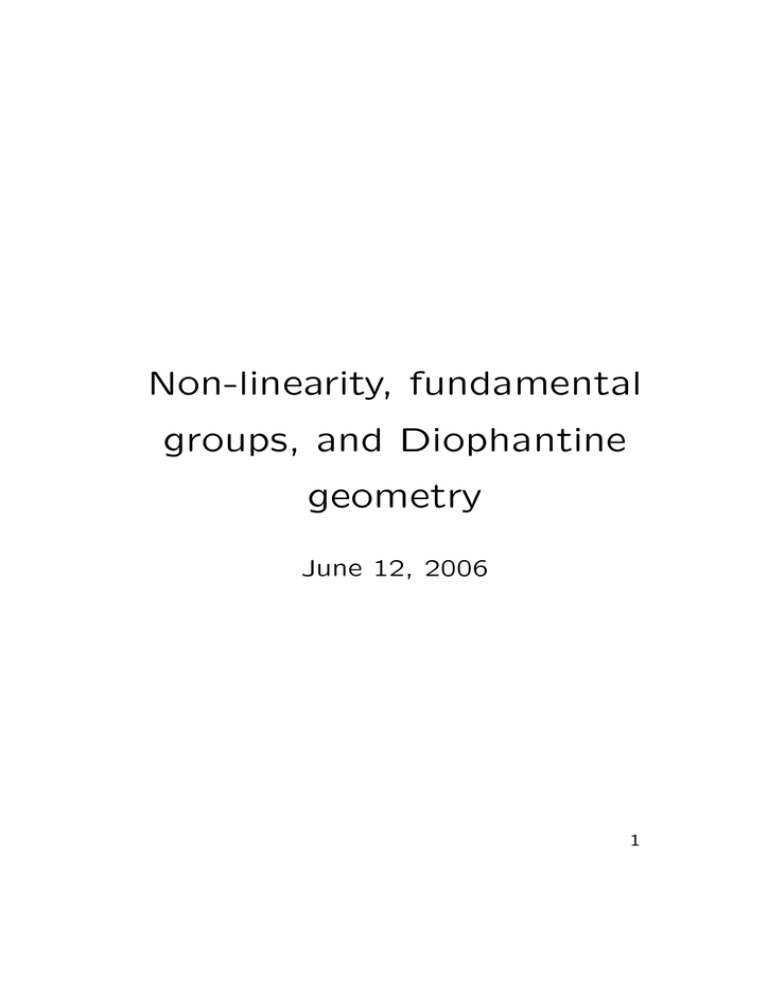
Non-linearity, fundamental
groups, and Diophantine
geometry
June 12, 2006
1
X: smooth variety over Q. So X defined by
polynomial equations with rational coefficients.
Arithmetic of X
%
Topology
Geometry
2
From 50’s to 80’s applications of topology to
arithmetic came primarily from homology:
-Basic language of homological algebra;
-Arithmetic cohomology theories.
3
These days, immediately associate to X at
least four different cohomology groups:
-H i(X(C), Q): Singular cohomology of topological space given by the complex points of
X.
-H i(X̄, Qp): Étale cohomology with p-adic coefficients.
i (X) = H i (X, Ω• ): The algebraic De Rham
-HDR
X
cohomology of X.
i (X mod p, Q ): The crystalline cohomol-Hcr
p
ogy of X mod p.
4
All have ‘formally similar’ linear structures. Also,
‘compatible’ in many ways, e.g.
H i(X̄, Qp) ' H i(X(C), Q) ⊗ Qp
Supposedly accounted for by a theory of ‘motives’:
Varieties −→
&
Motives
↓
Vector Spaces
5
A focal point of this lecture: In the homological approach, main ideas and techniques are
linear.
6
Important contrast:
Linear ↔ Non-linear
In topology,
Homology ↔ Homotopy
But also, the linear theory provides input into
the non-linear theory via linearization.
Topological version,
π1/[π1, π1] = H1
However, one expects a fully non-linear theory,
when fully understood, to be more powerful
than a linearized version.
The techniques of homotopy as applied to arithmetic should yield information not accessible
to homology.
7
Homology −→ study of L-functions.
Homotopy −→ study of Diophantine sets.
Note: L-functions also yield information about
Diophantine sets. But actually, linearized Diophantine sets. For example, might be interested in
X(Q)
the set of rational points. But L-functions give
information on something like Z[X(Q)].
Cannot yield, in any obvious way, Faltings’ theorem (Mordell conjecture), for example.
8
Classically, a basic ‘homological’ construction
used in Diophantine geometry of a hyperbolic
curve X is the Jacobian JX . A very linearobject:
JX :=
(Free abelian group generated by X)/(eq. rel.)
Itself an abelian group variety. Parametrizes
line-bundles on X.
Homological nature: Over C
JX = H1(X, Z)\H1(X, C)/F 0
9
If we fix a base-point x ∈ X, can map the curve
into the Jacobian
X→JX
y 7→ [x − y]
Thereby, we can view X as parametrizing line
bundles on itself.
Ends up being a key idea: parametrizing other
geometric objects using points of X.
Note: Can also express this map using abelian
integrals.
10
Weil tried to use this parametrization to prove
the Mordell conjecture. Doesn’t quite work
because J has too many points: also related
to linearity.
11
The eventual proof of Mordell conjecture involves a non-linear parametrization. A family
of curves (Kodaira-Parshin construction):
Z
↓
X
Somewhat ad hoc. Desirable to have a nonlinear version of Weil’s construction.
The idea of using homotopy in this regard stems
in part from Grothendieck’s ‘anabelian’ philosophy. Specifically, the section conjecture.
Main point: Relates X(Q) to the pro-finite fundamental group.
12
In fact, it turns out there is a non-linear Albanese map
X→classifying space
y 7→ [π1(X; x, y)]
13
Actual object involved is the De Rham fundamental group (Chen, Hain, Morgan,. . . ).
π1DR (X, x)
Unipotent completion of usual fundamental group.
Obtained by taking complex linear combinations Σcl [l] of paths and regarding two such as
equivalent if they have the same ‘parallel transport’ action on vector bundles with unipotent
connection.
14
Actually a pro-algebraic group. Each quotient
Z n+1\π1DR (X, x)
by a subgroup in the descending central series is a finite-dimensional unipotent algebraic
group.
15
Can also construct De Rham path spaces
π1DR (X; x, y)
which are torsors for π1DR (X, x).
These groups and path spaces have a Hodge
filtration
π1DR (X; x, y) · · · ⊃ F −2 ⊃ F −1 ⊃ F 0
and an integral lattice Ly ⊂ π1DR (X; x, y) coming from the image of the topological paths.
The torsor structure is compatible with the
extra structures. These torsors end up being
classified by
L\π1DR (X, x)/F 0
16
Non-linear Albanese map (Hain)
X −→ L\π1DR (X, x)/F 0
is given by
y 7→ [π1DR (X; x, y)]
Note: The ‘abelianization’ gives us the usual
Albanese map:
y 7→ [Z 2\π1DR (X; x, y)]
17
The most important point for Diophantine applications is that one can use this map to pull
natural functions back from the classifying space
to X.
For example, when X = P1 \{0, 1, ∞}, the algebraic functions on π1DR (X, x)/F 0 form a vector
space
C[αw ]
spanned by functions αw , indexed by words w
in a two letter alphabet {A, B}. The function
αw corresponding to the word
w = Ak1−1BAk2−1B · · · Akm−1B
gives rise to the function
z n1
Lw (z) = Σn1>n2>···>nm k
,
km
1
n1 · · · nm
a multiple polylogarithm. Ubiquitous in arithmetic, geometry, and physics.
More generally, the non-linear Albanese map
can be expressed using iterated integrals.
18
For arithmetic applications, need a p-adic version of the construction above: Theory of the
crystalline fundamental group and p-adic Hodge
theory. Leads to p-adic multiple polylogarithms
and p-adic iterated integrals. Important distinction from the archimedean theory is that
the functions we end up with are single-valued.
19
In the case of X = P1 \ {0, 1, ∞}, applies to the
finiteness of X(Z[1/S]) the set of S-integers.
(Theorem of Siegel.)
Theorem: On X(Zp) there exists a non-trivial
linear combination
Σw cw Pw
of p-adic multiple polylogarithms that vanishes
on
X(Z[1/S]) ⊂ X(Zp).
20
For compact curves of higher genus, reduces
Faltings theorem to conjectures of Beilinson.
These results come from the theory of the
motivic fundamental group (Deligne) and ‘linearization’.
Linearization:
0→Z n/Z n+1→π1M /Z n+1→π1M /Z n→0
21
Use of the motivic fundamental group:
X(Z[1/S])
→
π1DR (X ⊗ Qp, x)
↓
↑
Hf1(ΓS , π1et(X̄, x) ⊗ Qp) → Hf1(Gp, π1et(X̄, x) ⊗ Qp)
22
Perhaps can view as a partial vindication of
Grothendieck’s ‘anabelian’ vision. Especially
mysterious in that the anabelian philosophy
gets connected in the process to the theory
of (mixed) motives.
23
